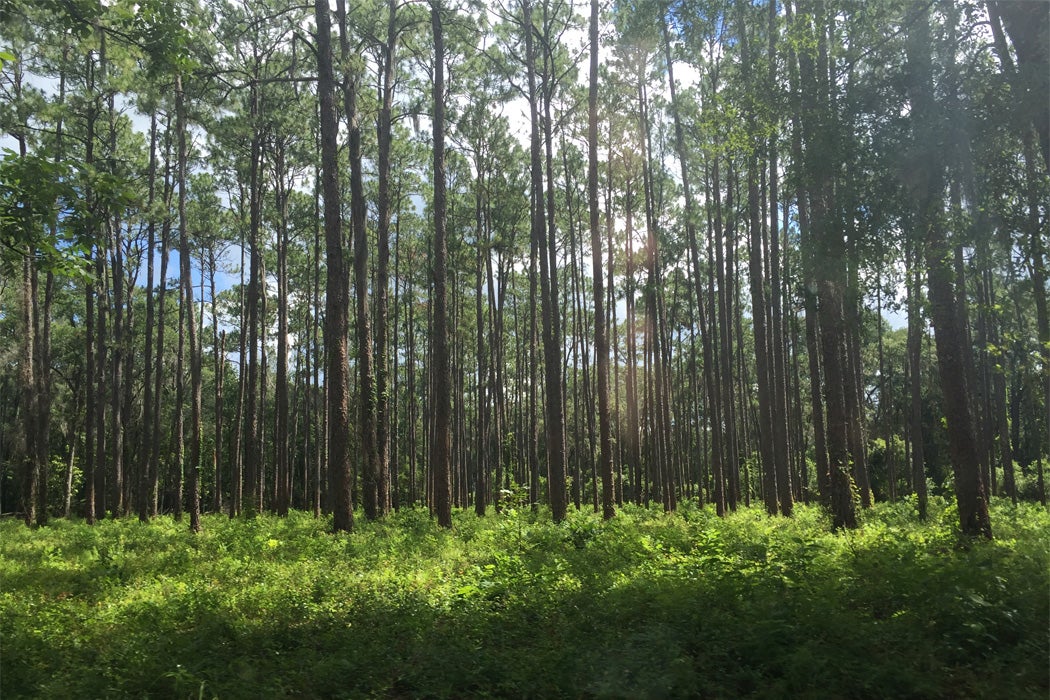If you’ve ever been to Brooklyn Bridge Park, you may have seen the sturdy, wooden-beamed benches facing the harbor. The wood for the benches was salvaged from the old National Cold Storage Warehouse complex, which was demolished for the construction of the park. It timber comes from the longleaf pine, Pinus palustris, some of which was cut in the decades before 1900. The trees themselves might have been up to five centuries old when they were felled.
The Brooklyn Bridge itself had caissons—essentially enormous, upside down boxes—made of longleaf pine. The foundations of the bridge’s two towers were excavated by men working inside these caissons on the bottom of the East River. Once the excavation was done—at terrible human cost, due to caisson’s disease, a.k.a. decompression sickness—the caissons were filled in to form the frames of the foundations of the bridge.
Even dead, the dense, resin-saturated, rot-resistant timber of longleaf pine survives a very long time. Many cities in the US have nineteenth-century buildings that were built with the “good bones” of longleaf pine. They’re harvested to this day, but not in the volume they once were. There’s a simple reason for that: There just aren’t that many of them anymore.
Geographers Garrett C. Smith, Mark W. Patterson, and Harold R. Trendell track the demise of the longleaf ecosystem. When Europeans arrived in the southeast, the pines covered the coast plain from what is now the Virginia/North Carolina border into Florida and along the Gulf Coast. Estimates of the total size of this pine savannah range from 60 to 147 million acres. There are far fewer of the trees now, and only a tiny proportion of the remnant is old growth. An example: in 1607, there was an estimated one million acres of longleaf pine in Virginia alone; in 2005, there were some 200 individual trees.
Europeans first took the trees for ship masts and naval stores like pitch, tar, and turpentine. The wood also turned out to be an incredibly durable construction material. Smith, Patterson, and Trendell call the centuries-long course of logging longleaf pine the “silent and extensive removal of a historically important ecosystem in the South.”
The era of “cut and get out” logging lasted until roughly 1930. There were markets for this wondrous pine across the US as well as in Europe and Central and South America. Longleaf pines, however, can take 150 years to reach maturity. When forests were replanted by the logging industry, faster-growing species like loblolly and slash pines were planted instead of longleaf.
Weekly Digest
The timber industry has also worked hard to suppress fire. Unfortunately, longleaf pine had evolved to withstand fire. In fact, it depended on fire to sweep away competing species and underbrush. Harvesting and fire suppression combined to decimation of this entire ecosystem. Over 900 plants, for instance, are associated with longleaf forests. But the poster species for these woodlands is the Red-cockaded Woodpecker. Once numbering in the hundreds of thousands, this bird was put on the endangered list in 1970. Efforts to ensure the bird’s survival—they nest in the mature living trees—have been one impetus to restore and foster longleaf pine forests.
The historic range of the Red-cockaded Woodpecker once stretched to New Jersey, which isn’t too far from the Brooklyn Bridge, which is built from the same trees on which the woodpeckers depend. Our cities were built with their homes.







